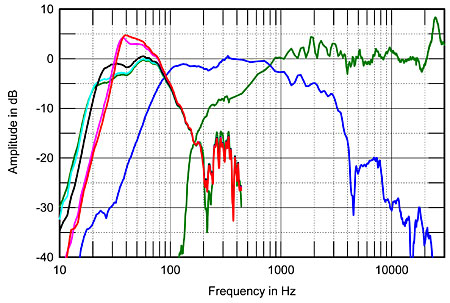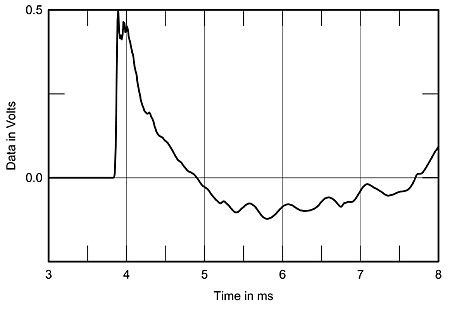| Columns Retired Columns & Blogs |
Vandersteen Model Seven loudspeaker Measurements
Sidebar 3: Measurements
Footnote 1: My measured response of the Sevens in Michael's room are very much worse than those taken by Richard Vandersteen and quoted by Michael in his review text. I suspect, therefore, that Richard must have placed his microphone much closer to each loudspeaker while taking his measurements, thus reducing the influence of the room acoustics.
Other than the in-room and nearfield measurements, for which I used an Earthworks QTC-40, the quasi-anechoic measurements of Vandersteen's Model Seven were all performed using DRA Labs' MLSSA system and a calibrated DPA 4006 microphone. The Seven has a low specified voltage sensitivity of 83.5dB/2.83V/m; my estimate of the figure was within experimental error of the specification, at 84dB(B)/2.83V/m. As well as requiring an amplifier capable of swinging enough volts to play at high levels, the Seven also needs high currents, especially with its rear tweeter switched on, when its impedance above 8kHz remains at a low 3 ohms (fig.1). The dip to 3.7 ohms in the upper bass, however, will be moderated by the fact that the line-level high-pass filter will have also started rolling off the low frequencies sent to the speaker's passive section.
The traces in fig.1 are free from any evidence of cabinet resonances. Investigating the enclosure's vibrational behavior with an accelerometer, I found no midrange modes, though the sidewall level with the upper-midrange unit did flex to a small degree at 39Hz (fig.2), and I detected a low-level mode at 700Hz on the rear wall above the terminal panel. The Model Seven's cabinet is as inert as it is beautiful.

Fig.1 Vandersteen Model Seven, electrical impedance (solid) and phase (dashed) with rear tweeter off (top trace) and on, set to its maximum level (bottom). (2 ohms/vertical div.)

Fig.2 Vandersteen Model Seven, cumulative spectral-decay plot calculated from output of accelerometer fastened to center of midrange-enclosure side panel (MLS driving voltage to speaker, 7.55V; measurement bandwidth, 2kHz).
The response of the line-level high-pass filter, which needs to be inserted in front of the amplifier used with the Model Seven, is shown in fig.3. With its internal switches set for the 100k ohm input impedance of the Audio Precision System One test set, the output is down by exactly 3dB at 100Hz, as specified. Unfortunately, though I thought I had the filter set correctly for the Musical Fidelity amplifier I used for the testing, it looks as if it was –3dB at 300Hz, an octave and a half higher in frequency. As the speaker had to be packed up and returned to Vandersteen immediately after I'd finished the testing but before I could analyze the results, the following measurements all show the lower-midrange unit rolling off a little earlier than it was supposed to. This underlines the importance with the Model Seven, as with the other Vandersteen speakers that use this filter, that the latter must be set correctly for the user's amplifier.

Fig.3 Vandersteen Model Seven, frequency response of unbalanced high-pass filter with internal switches set for 100k ohm input impedance of Audio Precision System One (2dB/vertical div.).
Even with this operational error, though the lower-midrange unit's output does start to shelve down below 300Hz, its response extends to 100Hz before rolling off with the expected 18dB/octave slope (fig.4, blue trace). Higher in frequency, the lower-midrange unit hands off to the upper-midrange unit (green trace) closer to 800Hz than the specified 600Hz, though the use of first-order crossover filters does result in quite a wide overlap between their outputs. The upper-midrange unit's balance appears to be a couple of dB too high in level compared with the levels of the lower-midrange unit and the tweeter, which takes over above 5kHz. The sandwich-dome tweeter features the usual ultrasonic peak in its output, but the Q is lower than with a metal-dome unit and its output in the octave below that peak is flatter than is usual with such tweeters. (All measurements, by the way, were taken with the grille in place, as it provides the necessary contouring of the acoustic environment around the upper-frequency drivers.)

Fig.4 Vandersteen Model Seven, acoustic crossover on upper-midrange axis at 50", corrected for microphone response, with nearfield responses of upper-midrange unit (green) and lower-midrange unit (blue), both plotted below 350Hz and taken with high-pass filter in-circuit. Nearfield response of powered woofer shown with Contour set to: "1" (green), "4" (cyan), "7" (black), "9" (magenta), "10" (red).
To the left of fig.4 are shown the powered woofer's output, with its Contour control set to "1" (green trace), "4" (cyan), "7" (black), "9" (magenta), and "10" (red). (The 11 bandpass equalizer pots were set to their central, flat positions for these measurements.) The Contour control adjusts not only the amount of midbass boost but the low-frequency cutoff. Peculiarly, the biggest response changes occur when the control is set between "7" and "10"; a light hand on this control will be necessary. I set the woofer-level control to give an apparent crossover of 90Hz, but it should be noted that there is plenty of woofer gain still available. Again, a light hand on this control will be necessary to get the best match of speaker and room.
Fig.5 shows how the individual responses sum on what I had understood from Richard Vandersteen was the optimal listening axis: level with the dustcap of the upper-midrange unit, which is 36.5" from the floor without the supplied spikes. Other than the slight energy excess between 1 and 3kHz noted earlier, and the premature shelving-down of the lower-midrange unit due to the inadvertent misadjustment of the high-pass filter, the Model Seven's response is impressively flat. The woofer's output is shown with its Contour set to "6"—the Seven's bass extends to 20Hz before rolling off, which is impressive performance.

Fig.5 Vandersteen Model Seven, anechoic response on upper-midrange axis at 50", averaged across 30° horizontal window and corrected for microphone response, with nearfield responses of lower-midrange unit and powered woofer with Contour set to "6," plotted below 300 and 450Hz, respectively.
The Seven's vertical dispersion, taken over a fairly narrow window and normalized to the upper-midrange axis, is shown in fig.6. It is important to note that the tweeter's output rises rapidly for axes above the midrange unit; you must sit on the intended axis if the Seven is not to sound a bit thin and peaky, and you must never listen to this speaker while standing. Laterally (fig.7), the Seven maintains its output over a wide window, though a touch too much energy is present off axis between 3 and 6kHz. This might make the speaker sound too bright in small or overreverberant rooms.

Fig.6 Vandersteen Model Seven, vertical response family at 50", normalized to response on upper-midrange axis, from back to front: differences in response 15–5° above axis, reference response, differences in response 5–10° below axis.

Fig.7 Vandersteen Model Seven, lateral response family at 50", normalized to response on upper-midrange axis, from back to front: differences in response 90–5° off axis, reference response, differences in response 5–90° off axis.
Fig.8 shows the spatially averaged response of the Model Sevens in Michael Fremer's listening room. As usual, I generated this graph by averaging 20 1/6-octave smoothed responses taken for each speaker individually in a vertical rectangular grid measuring 36" by 18" and centered on the positions of Mikey's ears in his listening chair (footnote 1). (I used an Earthworks omni microphone and a Metric Halo ULN-2 FireWire audio interface, in conjunction with SMUGSoftware's Fuzzmeasure 2.0 running on my Apple laptop.) The gentle high-frequency rolloff above 5kHz or so is pretty much perfect behavior, given the increasing absorptivity of the room furnishings in this region. I had wanted to use the woofer Level and Contour controls set to the recommended position for this measurement, but due to a miscommunication with Michael, the controls instead were set midway between Richard Vandersteen's preferred settings and Michael's. However, the 11 equalizer pots remained as they had been set up by Richard. While the equalization has resulted in a smoother curve than usual, the necessary placement of the speakers close to the corners of MF's room has given a large boost in the low bass. As MF noted, it appears that Richard Vandersteen does like his lows! Even with Michael's settings of the woofer Level and Contour controls, I could hear the effect of this boost as a somewhat disconnected quality to the bass, perhaps exacerbated by the relative lack of energy in-room between 100 and 500Hz. However, the boost in the low bass did add a considerable degree of majesty to the Model Sevens' sound in Michael's room.

Fig.8 Vandersteen Model Seven, spatially averaged, 1/6-octave response in MF's listening room.
Turning to the time domain, the Vandersteen Model Seven is one of the few speakers that produces a true time-coherent output from its multiple drive-units. All four drivers are connected with the same positive acoustic polarity, and the step response on the upper-midrange axis (fig.9) has a superbly well-defined initial transient to the step, though the small spike at the top of the step suggests that the optimal blend of the tweeter's output with those of the other drivers occurs slightly below this axis. Some ringing can be seen in the decay of the step; this is associated with some delayed energy between 2 and 4kHz in the cumulative spectral-decay plot (fig.10). I doubt that this is due to cone resonant modes, however.

Fig.9 Vandersteen Model Seven, step response on upper-midrange axis at 50" (5ms time window, 30kHz bandwidth).

Fig.10 Vandersteen Model Seven, cumulative spectral-decay plot on upper-midrange axis at 50" (0.15ms risetime).
While there are some small idiosyncrasies in the Vandersteen Model Seven's measured performance, it is overall an impressive feat of audio engineering. I echo Michael Fremer's enthusiastic endorsement of this design.—John Atkinson
Footnote 1: My measured response of the Sevens in Michael's room are very much worse than those taken by Richard Vandersteen and quoted by Michael in his review text. I suspect, therefore, that Richard must have placed his microphone much closer to each loudspeaker while taking his measurements, thus reducing the influence of the room acoustics.
- Log in or register to post comments




































